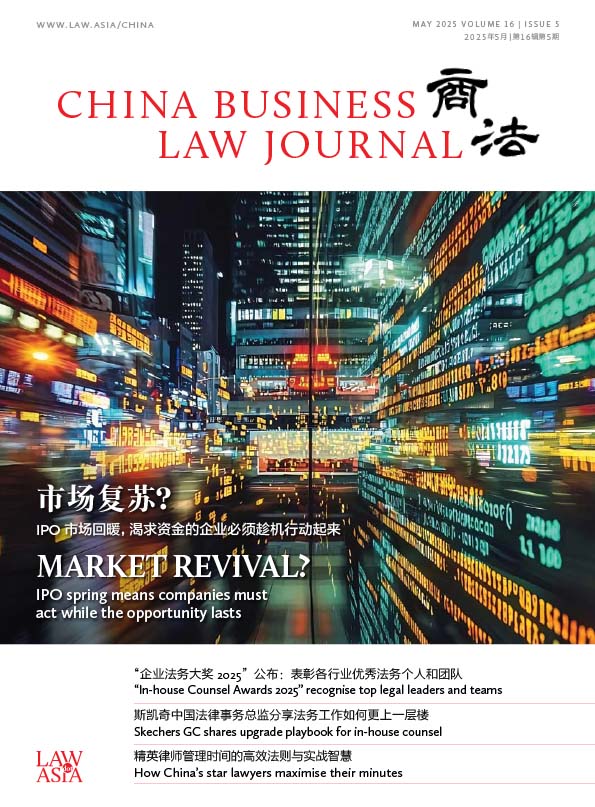BANKRUPTCY & REORGANISATION
Stay informed with expert insights and comprehensive analysis on China’s bankruptcy & reorganisation.
List of contents
Under the administrator-centric framework of the Bankruptcy Law, the administrator is a pivotal figure in bankruptcy proceedings… (Read more >)
3 March 2025
The bankruptcy restructuring process for listed companies plays a crucial role in the intricate landscape of China’s capital market, providing distressed enterprises a second chance while ensuring optimal resource allocation and market stability… (Read more >)
3 March 2025
Enterprises serve as the driving force behind national economic and social development, anchoring a critical foundation of China’s economic growth. But amid an overall downturn of the global economy, operational risks faced by enterprises are increasing daily, and bankruptcy has become a common phenomenon… (Read more >)
3 March 2025
Construction contractors are entitled to priority repayment from the proceeds of a project’s sale or auction to settle unpaid invoices. Since construction payments are significant and substantial claims in bankruptcy proceedings, their priority ranking against other debts draws considerable public attention… (Read more >)
28 February 2025
The pre-reorganisation system serves as a transitional mechanism between out-of-court restructuring and formal bankruptcy reorganisation… (Read more >)

Zhang Yao
Partner
Han Kun Law Offices
Tel: +86 21 6080 0386
E-mail: yao.zhang@hankunlaw.com

Wang Xiang
Associate
Han Kun Law Offices
Tel: +86 21 6080 0520
E-mail: xiang.wang@hankunlaw.com
28 February 2025
China’s new Company Law introduces major reforms in capital systems, shareholder liability and corporate governance, significantly influencing implementation of the Bankruptcy Law… (Read more >)
28 February 2025
In recent years, changes in national macroeconomic policies and real estate regulations have led to a steady rise in bankruptcy cases involving real estate companies. As key participants in such projects, construction firms not only hold substantial claims for project payments but also provide significant employment for migrant workers … (Read more >)
23 January 2025
The new Company Law, effective from 1 July 2024, has significantly impacted commercial entities, with shareholder responsibilities regarding capital contributions capturing the most attention. This article examines the duties of shareholders in companies that have entered bankruptcy liquidation or reorganisation under the new law, clarifying the boundaries of their responsibilities … (Read more >)
3 December 2024
Unfettered by bias towards the insolvency regime, which has long been perceived as debtor-friendlier, the market has embarked on an arduous and extensive journey, working to unravel the intricacies of achieving excellence in both bankruptcy approaches and execution … (Read more >)
20 March 2024
The implicated government guarantees in China’s bond market have been gradually broken in recent years. The Chaori Solar bond default in 2014 marked the first default on a publicly offered bond in China. According to the iFinD search results, 77 bonds were in default in 2021, involving RMB154.08 billion (USD24.3 billion) … (Read more >)


Wang Xiaodong
Senior Partner and Shanghai-based Director
Hai Run Law Firm
14 March 2024
The term micro and small enterprises (MSEs) generally refers to small businesses, micro businesses and home-based businesses. Because of the relatively limited funds and management capabilities, MSEs may fall into bankruptcy reorganisation as a result of difficulties in financing, excessive market competition and insolvency … (Read more >)


Cheng Ruomiao
Senior Partner
Leaqual Law Firm
3 February 2024
The group economy is derived from the market-oriented and large-scale development of the modern economy. However, any debt problem in a group economy is more likely to cause widespread and systemic risks amid continued macroeconomic downturns, oversupply and liquidity crises faced by pillar industries … (Read more >)
6 January 2024
Indicating a new trend, 15 listed companies completed reorganisations in 2023 while maintaining steady development, with 14 of them undertaking pre-reorganisation procedures. This clearly shows a continued increase in pre-reorganisation, compared with only seven among reorganisation rescues concluded in 2022 … (Read more >)
6 January 2024
Credit risk incidents have occurred frequently among China’s property developers since the second half of 2021. Even developers with a nationwide footprint have collapsed, such as Evergrande and Sunac. The number of delistings or winding-up petitions filed abroad against property developers has also reached an all-time high … (Read more >)
3 January 2024
The most important legal document in bankruptcy and reorganisation proceedings is the reorganisation plan, and the adjustment to the interests of investors is one of its core steps. Although methods for adjusting investor equity may vary, equity transfer is the most common … (Read more >)

Wu Yaohong
Associate
Lianyue Law Firm

9 November 2023
The Shenzhen Intermediate People’s Court (SIPC) ruled on 20 June 2023 that enforcement of the first case to date of personal bankruptcy reorganisation within its jurisdiction had been completed, with the debtor economically “reborn” … (Read more >)
9 August 2023
In the first few days of 2023, it had already been made clear that the year would again see an effort to resolve implicit debts of the government pushed forward, which will have a significant impact on the debt of urban investment companies … (Read more >)
4 April 2023
Compared with developed markets such as the US, with its modern bankruptcy law based on 130 years of history, China faces the duality of an infant bankruptcy mechanism and a complicated economic reality, where a growing number of business entities are in dire need of an exit … (Read more >)
1 March 2023
Most people tend to think of bankruptcy in the narrow sense: liquidation. A string of business bankruptcies in the 1990s perpetuated this idea. Since bankruptcy means all investments go down the drain, why would anyone in their right mind wish to invest in a bankrupt business? … (Read more >)
1 March 2023
Pre-reorganisation, or pre-packaged bankruptcy, enables companies to negotiate a restructuring plan with creditors and other stakeholders ahead of court-led reorganisation, when the agreed plan covering major issues such as debt liquidation, business restructuring and change of management is submitted to the court for review … (Read more >)
1 March 2023
Localisation of the personal bankruptcy system is not new in China. As early as 2007, when the Enterprise Bankruptcy Law was being formulated, the natural person bankruptcy exemption system was written into a proposed draft of the legislation. But, given the lack of theoretical basis or mature complementary systems at the time … (Read more >)
1 March 2023
Enforcement law is designed to settle individual debts, following the basic rule of “first come, first served”. Bankruptcy law, on the contrary, aims for equal settlement among the creditors … (Read more >)
27 February 2023
Reorganisations of listed companies have long been held as a barometer for reorganisation policies. As such cases link the capital market to the bankruptcy system, they have received widespread attention. Since the implementation of the Enterprise Bankruptcy Law in 2007, 103 listed companies have undergone reorganisation, about half of which took place during the past four years. These recent reorganisations have produced new features and raised cutting-edge legal questions, while driving reforms in and refinements to the existing reorganisation system and securities regulatory policies … (Read more >)
23 January 2023
Companies listed on China’s National Equities Exchange and Quotations (NEEQ), otherwise known as the “New Third Board”, are considered unlisted public companies. So the question arises: What provisions or regulatory requirements should insolvency administrators be concerned about when they enter bankruptcy, or its ancillary proceedings, due to financial difficulties? … (Read more >)
2 January 2023
On 13 October, the China Banking and Insurance Regulatory Commission (CBIRC) promulgated the Measures for the Administration of Finance Companies of Enterprise Groups. Set to come into effect on 13 November, the measures contain chapters dedicated to the risk disposal and market exit of finance companies under enterprise groups … (Read more >)
29 November 2022
Limited liability of shareholders is an important feature of modern companies. Article 3.1 of the Company Law provides that the liability of a shareholder shall be limited to the amount of their capital contribution/the number of their subscribed shares. However, under special circumstances, such as when a shareholder neglects to fulfil liquidation obligations, resulting in a failure to liquidate the company due to the loss of company property, the limited liability system may not suffice … (Read more >)
22 November 2022
Almost without exception, property developers plagued by bankruptcy prospects find themselves at the end of their ropes in terms of liquidity. Considering the day-and-night difference in the market value of a property, the costs of and difficulties in its disposal, before and after project completion, as well as the need to maintain social stability … (Read more >)
28 October 2022
As part of the State Council’s efforts to reform the overall business environment, six major cities – Beijing, Shanghai, Chongqing, Hangzhou, Guangzhou and Shenzhen – have since the end of October 2021 been part of a pilot programme aimed at creating a more transparent and efficient exit mechanism for market players. Among the reforms, creditors of bankrupt companies will be allowed to recommend administrators to be appointed by the courts … (Read more >)
29 July 2022
Debtors satisfying bankruptcy conditions under the Enterprise Bankruptcy Law may file with a competent court to gain protection in the form of ceasing interest accrual, release of preservation, suspension of execution, release from unfulfilled contracts, or restoration of credit. Lawful entry into bankruptcy proceedings grants debtors an edge in negotiations … (Read more >)
27 June 2022
As a growing number of listed companies seek to revamp their creditor-debtor relationships through bankruptcy, prior listing rules at both Shanghai and Shenzhen stock exchanges have become inadequate for guiding bankruptcy-related operations … (Read more >)
3 May 2022
In recent years, due to macroeconomic trends, national policies and raised legal awareness, courts have been accepting a notably increasing number of corporate bankruptcy cases. Meanwhile, the likelihood of financing and financial leasing companies (the lessors) encountering bankruptcy reorganisation of lessees during the lease term has likewise multiplied … (Read more >)


Chen Zhuo
Partner
Tian Yuan Law Firm

Wang Hao
Associate
Tian Yuan Law Firm
3 May 20222
Amid the global economic slowdown and pandemic pressure on the financial landscape, a number of enterprises have gone bankrupt, including, among others, construction companies. Once entering the reorganisation process, depending on its mode of profit and operation, migrant workers often become creditors of reorganised enterprises … (Read more >)


Cheng Ruomiao
Senior Partner
Leaqual Law Firm

Wang Anyi
Associate
Leaqual Law Firm
21 March 2022
The first bankruptcy case in China, the bankruptcy of Shenyang Explosion-proof Equipment Factory, occurred in the early 1980s, serving as the prelude to enterprise bankruptcy practice in China. Now, 17 years have passed between the legislative proposal for China’s Enterprise Bankruptcy Law first being made and its final promulgation … (Read more >)
17 February 2022
Article 10 of the Opinions of the State Council on Further Improving the Quality of Listed Companies provides that listed companies planning to carry out bankruptcy reorganisation should first put forward a feasible resolution for any issue of fund occupation and illegal guarantee, making it an important part of a reorganisation application … (Read more >)
16 February 2022
Since its debut in the bankruptcy reorganisation case of Bohai Steel Group in 2016, the trust mechanism has routinely appeared in high-profile bankruptcy reorganisations such as that of Tewoo Group, Founder Group and HNA Group, for the purpose of effectively balancing the interests between the parties and smoothly proceeding with the reorganisation. This article will explore the legal aspect of the trust mechanism in bankruptcy reorganisation service … (Read more >)
10 February 2022
Ever since Evergrande Group’s debt bubble burst in September this year, the company’s financial crisis has rarely been out of the headlines. On 3 December, it announced it was exploring ways to restructure its debt, including solutions to its overseas liabilities and actively promoting overseas debt restructuring. Then, the Guangdong government stepped in, announcing that it would dispatch a working group to the company. A few days after that, Evergrande’s board announced the formation of a risk management committee … (Read more >)
28 January 2022
According to article 31 of the Enterprise Bankruptcy Law, the administrator has the right to request the court to rescind certain acts involving the debtor’s property that occurred within one year before the court accepts the bankruptcy application, including the “gratuitous transfer of property” … (Read more >)
27 January 2022
As the coronavirus pandemic has ravaged companies and the global economy, the social value of bankruptcy has been taken more seriously and fully demonstrated. Not only the small and medium-sized private firms less able to fend off risks, but troubled state-owned enterprises (SOEs), once assumed to be too big to fail, have chosen to enter bankruptcy with the aim of being reborn … (Read more >)
26 January 2022
Operating and financial leases are becoming more and more common, and the number of cases where leasing companies participate in bankruptcy reorganisations as creditors has also increased. What are key points the lessor should pay attention to when facing the lessee’s entry into bankruptcy reorganisation? … (Read more >)
20 January 2022
When heavily indebted non-financial companies suffer a liquidity crunch or default on repayment, creditors can often panic and spark an all-out scramble to recover their money that seems to be intent on squeezing the debtor company dry. To provide a more orderly resolution of companies’ debt problems, regulators are gradually improving … (Read more >)
1 January 2022
Even leading real estate companies have not been exempt from the financial crisis under China’s stringent regulatory environment. As of 24 August, 244 real estate groups declared bankruptcy in 2021 – or almost one a day. As some of these businesses remain sound investment targets due to their quality land resources, investors are drawn to the potential of the reorganisation process … (Read more >)
24 November 2021
The combination of China’s structural reforms with the coronavirus pandemic has forced many companies into bankruptcy proceedings. Bankruptcy and reorganisation offers a brand new opportunity for companies with advanced technology, valuable brands or high-quality assets. However, successful reorganisation depends on the outcome of the process for recruiting new investor … (Read more >)
17 September 2021
Recently, the Supreme People’s Court (SPC) and the government of Hong Kong Special Administrative Region signed the Minutes on Mutual Recognition and Assistance of Bankruptcy Proceedings by the Courts of the Mainland and the Hong Kong Special Administrative Region. The SPC subsequently issued the Opinions on the Pilot Project of Recognition and Assistance of Bankruptcy Proceedings in the Hong Kong Special Administrative Region … (Read more >)
24 June 2021
The pre-organisation process gives an optional system for troubled companies, capital contributors, creditors and reorganisation investors to solve their problems flexibly under the supervision of courts. At present, there are no clear provisions on the pre-reorganisation system in Chinese law, but the system is taking its shape based on the provisions of the principal documents of several government departments of the State Council and the Supreme People’s Court (SPC) … (Read more >)
22 June 2021
The most common investment object of non-performing assets is the package of non-performing claims. Investors, in acquiring non-performing claims, often pay too much attention to the realisation and recovery value of the collateral, and ignore some special matters affecting the disposal cycle of non-performing claims, thus affecting the investment yield. This article suggests the key issues that investors should pay attention to when purchasing non-performing claims … (Read more >)
19 March 2021
On 8 June 2020, Sinomach Heavy Equipment Group relisted A shares, five years after delisting on 23 April 2015. The relisting of Sinomach has given hope to numerous investors who have considered investing in delisted stocks. In fact, the number of delisted enterprises that announce bankruptcy reorganisation plans with a view to relisting is not insignificant, with some currently in the course of applying, including Hui Lyu 5, Powerise 5, Nanyang 5, etc … (Read more >)
6 January 2021
In recent years, the number of bankruptcy cases has increased significantly, and the issue of the cases involving both criminal and civil liabilities has become more prominent, especially in the case of enterprise bankruptcy, where an enterprise or its actual controller, executive or legal representative is often involved in criminal crimes … (Read more >)
24 June 2020
A bankruptcy reorganization is conditional on a multifaceted and effective valuation of the enterprise’s property, claims and debts, as the results of such a valuation will directly affect the creditor repayment rate and the enterprise’s reorganization direction … (Read more >)
15 June 2020
For some companies the pandemic was the last straw, but there may yet be redemption and a chance to start again. Frankie Wang explains the latest developments in bankruptcy and restructuring in China … (Read more >)
12 June 2020







































































